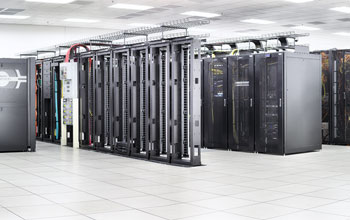Blue Waters, one of the world’s most powerful computers, opens for research
April 2, 2013
Blue Waters, one of the most powerful supercomputers in the world, was formally declared available for use today at the National Center for Supercomputing Applications at the University of Illinois at Urbana-Champaign (UIUC).
Blue Waters, a partnership among NSF, the State of Illinois, the University of Illinois and the Great Lakes Consortium for Petascale Computation, is capable at peak performance of nearly 12 petaFLOPS (12 quadrillion floating point operations per second) and has demonstrated sustained system performance of more than one petaflop on a range of commonly-used science and engineering applications.
This capability puts Blue Waters in a class by itself. By balancing processor performance characteristics with memory and storage attributes, it offers usable and efficient petaflop performance for large-scale scientific applications at the frontiers of computational science.
Blue Waters has been available to research teams in a friendly-user mode since March 2012. To date, more than 30 science and engineering teams have been allocated time on Blue Waters. By enabling advancements in research related to elementary particle physics, molecules and materials, tornadoes and climate change and cosmology, their studies will provide insights into the fundamental nature of matter, the basic constituents of the everyday world, critical processes on the earth, as well as the evolution of the universe.
“With Blue Waters, scientists are beginning already to predict the behavior of complex biological systems, understand how the cosmos evolved after the Big Bang, design new materials at the atomic level, predict the behavior of earthquakes, hurricanes and tornadoes, and simulate complex engineered systems like the power distribution system of airplanes and automobiles,” said Alan Blatecky, NSF division director for Advanced Cyberinfrastructure.
Modeling HIV
Blue Waters is enabling Klaus Schulten and his team at UIUC to describe the HIV genome and its behavior in minute detail, through computations that require the simulations of more than 60 million atoms. They recently published a paper in PLOS Pathogens touting an early discovery that may eventually lead to uncovering the structure of HIV.
The researchers described a smaller virus associated with HIV, which could only be achieved through a 10 million atom, molecular dynamics simulation, inconceivable before Blue Waters. The team is using Blue Waters to investigate complex and fundamental molecular dynamics problems requiring atomic level simulations that are 10 to 100 times larger than those modeled to date, providing unprecedented insights.
Global climate change
Cristiana Stan and James Kinter of George Mason University use Blue Waters to engage in topical research on the role of clouds in modeling the global climate system during present conditions and in future climate change scenarios.
Earthquake prediction
A team at the Southern California Earthquake Center, led by Thomas Jordan, carries out large-scale, high-resolution earthquake simulations that incorporate the entire Los Angeles basin, including all natural and human-built infrastructure, requiring orders of magnitude more computing power than studies done to date. Their work will provide better seismic hazard assessments and inform safer building codes: Preparing for the Big One.
Flood assessment, drought monitoring, and resource management
Engineering Professor Patrick Reed and his team from Penn State, Princeton and the Aerospace Corporation, use Blue Waters to transform understanding and optimization of space-based Earth science satellite constellation designs.
Fundamental properties of nature
Robert Sugar, professor of physics at the University of California, Santa Barbara, uses Blue Waters to more fully understand the fundamental laws of nature and to glean knowledge of the early development of the universe.
“Blue Waters enables us to perform the most detailed and realistic simulations of sub-atomic particles and their interactions to date,” said Sugar. Studies such as these are a global endeavor, and the large data sets produced on Blue Waters will be shared with researchers worldwide for further discoveries.”
